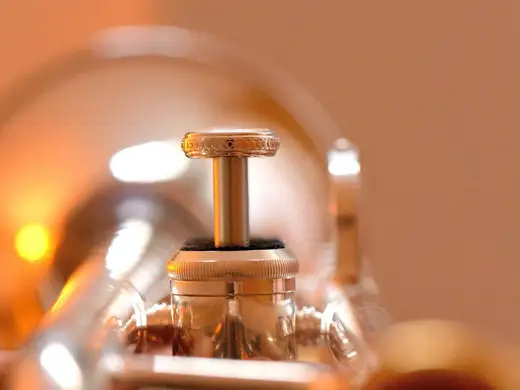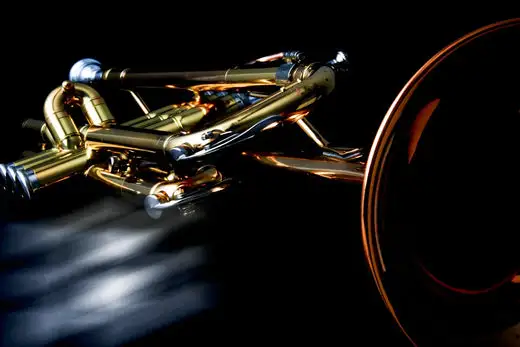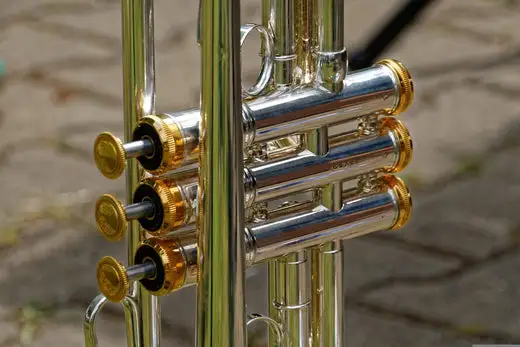Mouthpiece School 101
The mouthpiece may be the most crucial equipment choice a student can make other than his/her trumpet playing. It is also the easiest thing to change in one’s playing to achieve a variety of colors and specialty techniques, such as lead playing or orchestral playing; a dark sound versus a bright sound.
Trumpeters seem to be on a constant quest for the perfect mouthpiece. The question is, is it out there? The answer is, yes, but some trial and error is needed to find the one that is best suited for you.
Throughout history, mouthpieces have been made from horns, wood, plastic, and brass. Though the mouthpiece has undergone some changes since its inception, its fundamental role has not. Air leaves the body through the oral cavity of the mouth, creates the lips to vibrate as the lips are tensed. The vibrations then enter the mouthpiece resulting in a specific tone, subject to the openness or closeness of the oral cavity, tongue placement, and aperture tightness or looseness. The resulting tone is then carried into the trumpet and amplified by the trumpet. Essentially, the mouthpiece is the core resonating factor in trumpet playing and the trumpet is only an amplification of the mouthpiece itself.
With that being said, every trumpeter has a personal relationship with their mouthpiece. It has been selected from many, as the best feel, sound, rim, etc… But with so many small alterations that equal such dramatic differences, trumpeters seem to always be tinkering with their mouthpieces. You noticed I said mouthpieces, trumpet players just don’t have one, we have two, three, four and some people have managed to collect hundreds over their career. Why so many, easy, they’re looking for the holy grail of mouthpieces. Many have found it; many have not. If you have not, be patient, it’s out there, there’s one for all of us.
A Compliment for Us
A mouthpiece should compliment what your students are trying to do, not allow them to do something they can’t. A good mouthpiece will ease their high range, blow free and easy in the middle and low range, have a good pitch center, good endurance, and be comfortable on their lips at all times. But, under no circumstances should they be looking for a mouthpiece to suddenly supply them with all the answers they have been looking for in their playing. Again, a good mouthpiece suited for the genre of music they are playing will compliment them and help their playing, not fix musical or technical issues that are present during whichever mouthpiece they play.
Patience
After your student starts playing on their new mouthpiece, remind them to be patient. They may notice that their endurance and range diminishing somewhat over a couple of weeks. But, this is a natural effect after switching mouthpieces. When you switch mouthpieces, generally, there will be minute adjustments in the embouchure to allow for the new rim and added or reduced airflow resistances. If fatigue and soreness set in, have your trumpeter take a couple of days off to allow his new used embouchure muscles to recover and rebuild their strength. After a couple of days of rest, have them ease back into their playing routine with nice slow warm-ups that require little embouchure strength, pressure, and movement. In addition, have them concentrate on how the mouthpiece is feeling and reacting in their playing. Keeping a log is a good idea to track their progress during this transaction. As for their daily practice sessions, have them practice no longer than 45 minutes to an hour. You want them to exercise these new embouchure muscles, not deplete them. If they keep running the muscles to depletion each day, they will never build endurance because their muscles will be too tired and sore to snap back each day. After two to three weeks, they should have acclimated to the new mouthpiece and their muscles should have built up enough strength and endurance for them to return to their normal every routine.
Selecting a Mouthpiece
Have your trumpet student select a mouthpiece that is comfortable for them; however, does not compromise their sound and technique for comfort. Professional trumpeters play on all sorts of different mouthpiece sizes and brands, so there are many options. Have your student take their time in order to make the right decision. You or their private lesson teacher should accompany them in their quest for a new mouthpiece.
Tips for Choosing a New Mouthpiece
Before they try their new mouthpiece, make sure they warm-up and daily routine on their standard equipment. This will get them in shape and give them a basis for comparison. Choose a room with good acoustics. Too little or too much reverberation can alter the true sound production of the mouthpiece and trumpet combination. It is best, if possible to have them playtest their new mouthpiece in an environment you are familiar with the sound acoustics of. Having you or their teacher in front of the bell to hear the sound will be greatly different from the sound the student is hearing from behind the bell. You will make a difference being there for them. While trying their new mouthpiece, have them take frequent breaks so that their chops are as fresh as possible for each new mouthpiece they try. This allows for a fair comparison of equipment. If the student is trying more than one new mouthpiece, mix up the order of the mouthpiece they are trying so they do not become biased by knowing what mouthpiece they are trying. Chances are, they will be surprised which one they like because it may not be the one they were hoping for. Once they have chosen a new mouthpiece size they like, have them try playing several of the same size. Again, there are even small variations between like mouthpiece sizes. Once they find a new mouthpiece they like, remind them to give it a fair chance through the ups and downs of the first couple of weeks. Have them place your old mouthpiece somewhere they won’t reach for it in a time of need. If their new mouthpiece is not performing as they and you would like, after one month, they should begin a new search with a better idea in mind of what they are looking for in terms of feel and performance.
Dental Characteristics
Examine the student’s dental structure. If a student has any front teeth that are protruded, sideways, or missing, the student may be limited in their comfort and embouchure development if they are unable to make the necessary adjustments. While there are many famous players who have irregular teeth, each student will need to overcome these idiosyncrasies in order to develop correctly, and some problems will cause greater frustration than others. It is not unusual for the student to have an overbite or underbite, which will create unevenness in mouthpiece pressure and lip vibration. This unevenness will tend to impede embouchure development, sound production, and endurance. An extreme overbite or underbite will greatly hinder their chances of being successful at the instrument. If a student with irregular dental structure chooses to play the trumpet, they should begin private lessons as soon as possible. A good teacher can help the student balance their embouchure and mouthpiece placement. For example, students with an overbite may need to push the lower jaw forward to create a more balanced playing surface and correct the direction of the air flow.
Shape and Size of the Lips
Students’ lip characteristics will affect their success on the trumpet and will also determine which mouthpiece is most suitable for them. While there is some individual variation in mouthpiece preferences and lip characteristics, there are a few general guidelines that teachers can use to help students get started. While the 7C or 5C mouthpiece is the most common for beginners, the mouthpieces referred to below (Bach sizes 5B and 10 ½ C) should also be available during the screening process for students with different lip sizes, so the teacher can identify the best fit. This way, the student can purchase the appropriate size when they go to rent or buy their instrument.
Students with larger lips will be more comfortable on a mouthpiece with a wider inner rim (the open center of the mouthpiece), such as the Bach 5B. A large inner rim will allow the student’s lips room to vibrate, while an inner rim that is too narrow will pinch into the fleshy part of their lips, causing issues in tone, aperture flexibility, and endurance. While many directors may suggest trombone or tuba for students with very full lips, these students can be excellent trumpeters with the correct setup and mouthpiece.
While students with slightly thinner lips can play a standard 7C mouthpiece, players with extremely thin lips should choose a mouthpiece with a narrower inner rim, such as Bach 10 ½ C. If the rim is too large, the students will have to use additional mouthpiece pressure to make the lips vibrate, and the mouthpiece will demand more embouchure strength than they have. The result will be soreness and poor endurance.
Some students may have a teardrop lip, in which the front part of the lip comes down further than the rest of the top lip. Since this lip formation can lead to an unreliable response, fluttering in the sound, a downward air stream, and aperture control issues, the teardrop lip is generally not well-suited to the trumpet.
If a student with a teardrop lip has their heart set on playing trumpet and understands the difficulties associated with their lip shape, private lessons can help them develop strategies to minimize its impact on their playing. Since there are several techniques the student will need to use in establishing a good, working embouchure, early tutoring will be crucial to their success.
The Schilke 13C4 can be a good mouthpiece choice for students with a teardrop lip. It is comparable to a Bach 3C, but it has more rim surface area and is slightly more flat, helping to stabilize the teardrop portion of the lip. Its more funnel-shaped cup also allows the lips room to vibrate.
Types of Mouthpieces
Like most things in life, there is always more than one choice of just about anything, and mouthpieces are not immune from that. There are many different types of trumpet players in the world, and there needs to be a variety of mouthpieces to satisfy those players. Here are five of the most typical:
Visualizers: A mouthpiece visualizer is a tool used by many trumpet teachers and directors to more accurately inspect the embouchure of a student. This tool comes in two styles.
The first style of visualizers is a trumpet rim connected to the shank of a mouthpiece by two long, thin support rods and is actually placed into the trumpet like a standard mouthpiece. The cup is essentially missing from the frame of the mouthpiece. This allows the teacher to see directly into the rim of the mouthpiece and analyze what exactly the lips are doing while they are buzzing or to see the embouchure set-up prior to buzzing.
Another benefit of this style of visualizer is the student can direct their air from the rim directly into the shank of the mouthpiece. The teacher and student can then check to see if the air direction is upwards, downwards or straight out. If the air is directed straight out, you and the student will be able to hear air entering the instrument. Directing straight air into the instrument is a great exercise to work on if the student is having trouble focusing their sound. However, many great trumpeters in history have had air directions that go any which way. Find what works best for the student and work with that concept. Each student is different.
The second style of visualizer is a trumpet rim connected to a single metal rod to be held in the student’s hand. The investigations are the same by the teacher only the style of visualizers are different.
Standard: Well, the standard mouthpiece is probably what you see every day. No new ideas are really present here. It has the typical trumpet rim, cup, throat, and backbore found stock or customized from the factory. The customizations you can make are rim, cup, throat, and backbore selections. But, the mouthpiece looks like the traditional trumpet mouthpiece, no other features are present.
Screwrim: Screwrim mouthpieces were developed for players to use different rims with different cups backbores. Most players want to keep their same rim but change to different backbores and throats used for different styles of music or trumpets. Big cup and large backbore for symphonic playing while the player can maintain the same rim but change to a more shallow cup and tighter backbore for jazz or lead work. While maintaining the same rim, the comfort similarities to the players’ lips are kept while changing other factors of the mouthpiece like throat and backbore. For a maintenance tip, put just a drop of valve oil on the threads every other week or so to keep the rim from locking to the underpart.
Mega-tone: A mega-tone mouthpiece is much like a standard mouthpiece; however, there is a substantial amount of weight added to the body of the mouthpiece, about double the mass. The standard throat size of a mega-tone mouthpiece is a 26 throat allowing for more air to be passed through the mouthpiece giving the player a better chance to play at louder dynamics without distortion due to its added mass. This idea came from player seeking a darker, warmer sound in their playing. By adding weight to the mouthpiece, it enables the player to push their sound to louder levels with less distortion and while adding warmth to their overall sound in all ranges of the trumpet.
Asymmetrical: Developed by John Lynch, this mouthpiece used for enhancing your high range playing. For more information on this mouthpiece, visit www.asymmetric-mouthpiece.com/. A special cup design allows for higher notes to be achieved along with lessening the typical mouthpiece pressure to those extreme ranges.
Flugel Cup and Trumpet Shank (Fluffy): This mouthpiece is a hybrid of two different styles. It combines the cup and of a flugelhorn mouthpiece with the rim and shank of a trumpet mouthpiece. The end result is a warm, velvety sound desired for quiet passages or lyrical solos as desired.
Bent Mouthpieces: These mouthpieces are intended for players who have a very severe overbite or underbite that is not correctable by simply pushing or pulling the bottom jaw forward or backward. These players play with an acutely downward or upward slant to their trumpet. A slanted or bent mouthpiece can correct the trumpet’s position but not the dental issues. These mouthpieces can be bent anywhere from eight to twelve degrees by various mouthpiece makers.
Mouthpieces for Different Trumpets
- Trumpet: Uses a trumpet mouthpiece.
- Cornet: The cornet mouthpiece is different from a trumpet mouthpiece – its shank is smaller in diameter as well as shorter. A traditional cornet mouthpiece has a deeper and more conical cup, like that of a flugelhorn, bringing out the warm cornet sound.
- Flugelhorn: Even though a flugelhorn mouthpiece looks a lot like a cornet mouthpiece, they are very different. One, the cup of a flugelhorn mouthpiece is much more funnel cupped. Two, the shank of a flugelhorn mouthpiece is slightly different from that of a cornet shank. They are approximately the same size in length, but the shank taper of the flugel is shaped more for a flugelhorn receiver which tends to be a little larger than that of a cornet.
- Eb/D Trumpet: These trumpets use a trumpet mouthpiece.
- F/G Trumpet: This specialty trumpet utilizes a trumpet mouthpiece.
- Piccolo Trumpet: This modern Baroque trumpet can use either a trumpet or cornet mouthpiece depending on the mouthpiece receiver the manufacturer has installed on the instrument. When placing an order for one of these instruments, specify what type of mouthpiece receiver you want, either a trumpet or cornet receiver. Typically, most professional trumpeters perform this instrument with a cornet mouthpiece. The smaller, tighter cornet mouthpiece backbore helps the smaller piccolo trumpet maintain its characteristic sound.
Plating Effects of Mouthpieces
Mouthpieces are made from raw brass at first. Later they are plated to the manufacturer’s request and/or individual customer.
- Raw Brass: Mouthpieces are made from brass, but because of the chances of getting brass poisoning, each new mouthpiece is plated in silver. It is actually illegal for a manufacturer to sell a customer a mouthpiece not plated. Legal issues keep them from doing this.
- Silver: Tends to stick or grip to the lips better than gold. Silver plating is standard for any mouthpiece.
- Gold: Gold warms up to your lips faster than silver because gold conducts heat better than silver. Gold is also a little heavier than silver adding some weight to the mouthpiece as well. Gold plating also allows the lips to move a little more freely (less grip) for players playing with a wet set.
- Plastic or Lucite Rims: These rims are great for players who may have an allergy to silver or gold plating. Great for also playing outside when temperature conditions that are less than desirable. These rims are available for screwrim mouthpieces. Another idea would be mouthpieces make from plastic. These mouthpieces are only recommended for players to use for a short time. They are great for extreme temperature use and casual buzzing in the car. They are fairly inexpensive and are very durable. The resonances on these mouthpieces are not as great as the standard brass mouthpieces.
How to Read Mouthpiece Numbering
With Bach being the standard for mouthpiece comparisons, it’s best to use them as the measuring tool.
The numbers that refer to the mouthpieces, for example, 1.5 C refer to the rim circumference. As the numbers go upward the inner rim gets smaller. As the numbers get smaller the inner rim gets bigger. Bach mouthpieces range in size from a 1 to a 20.
The letter in the above example refers to the cup size. As the letter gets bigger, the cup size gets smaller; as the letter get smaller, the cup size gets bigger. A “*” is the largest cup you can order, commonly referred to as a “straight one”. You may find that these mouthpieces are also labeled with just a number and no letter. This denotes a straight. The most common large cup trumpeter’s use is a “B” cup, used a lot for low section playing or just a larger cup to allow a student who has larger lips more room to resonate. The most commonly, everyday used cup is the “C” cup. The “C” is referred to as a medium cup.
Most all mouthpiece manufacturers will understand the above language if you are asking for a mouthpiece to be made or sent to you if you explain the above information in the style you want your mouthpiece to reflect.
Wet-Set vs. Dry Set
Wet vs. Dry has been a question that has been asked more times then I can remember. The amount of lip wetness applied to each person’s lips is an individual one that cannot be quantified. Generally speaking, player’s lips need to be supple to vibrate with ease. Supple does not necessarily mean wet, but soft and not chapped. Keeping one’s self well hydrated is a great way to keep your lips supple. Another is applying vitamin E to your lips once a week or so. Most players that play with a dry set have very little wetness to their lips when they play but have supple lips. Playing with a quote, “dry-set” also gives the player a sense of grip or definite position to the mouthpiece’s placement on their lips. These players also describe playing “wet” as the mouthpiece feels slippery and not trusting that it will stay in its set position. A dry set player will often lick the inner part of their lips before they play, versus licking the outer part of their upper and lower lips, like wet-set players do, creating moisture on the outside of the lips. By dry players licking or moistening the inner lips and aperture allows for better resonance from the lips but gives the illusion the mouthpiece is set in place and not going anywhere.
Dental Issues and Mouthpiece Position
Ideally, the mouthpiece needs to be center over the top and bottom lips and centered from left to right from the corners of the mouth. By doing this you are aligning the aperture hole with the mouthpiece throat to allow for a direct air stream into the mouthpiece. With that being said, there are many occasions where that might just not be possible. A student’s dental structure has a lot to do with their comfort in their mouthpiece placement and rim of the mouthpiece.
Examine the student’s dental structure. If a student has any front teeth that are protruded, side-ways, or missing, the student may be limited in their comfort and embouchure development if they are unable to make the necessary adjustments. While there are many famous players who have irregular teeth, each student will need to overcome these idiosyncrasies in order to develop correctly, and some problems will cause greater frustration than others.
It is not unusual for the student to have an overbite or underbite, which will create unevenness in mouthpiece pressure and lip vibration. This unevenness will tend to impede embouchure development, sound production, and endurance. An extreme overbite or underbite will greatly hinder their chances of being successful at the instrument. Moreover, students with an overbite may need to push the lower jaw forward to create a more balanced playing surface and correct the direction of the air flow.
You want to accommodate your students as much as possible, however, do not accept comfort vs. overall growth and future development of the embouchure. Work with your students to find a position for their mouthpiece that is comfortable but also has a good position to allow for further development.
Mouthpiece Rim
The rim of any brass mouthpiece is made up of essentially four main parts: The rim diameter, width, contour, and edge or bite. The rim choice for many players is a very important decision. The rim decides comfort and endurance for the player. A sharper inner edge to the mouthpiece rim will produce a cleaner more pronounced attack whereas a rounded inner rim allows for a smoother rounded attack. As far as outside rim width is concerned, the more rim you have in contact with the flesh the less free the lips are to resonate. In addition, if the width of the outside rim is too much it could also pinch open the aperture allowing problems with endurance and flexibility and range. A medium-wide rim is best recommended, typically what is found on standard Bach mouthpieces. The inner edge of the rim can also affect a student’s playing. If the edge is too sharp it can reduce endurance by pushing into the flesh or the lips too far. However, a sharper edge will also help with control. It allows the proper amount of flesh to vibrate. If the rim is too narrow, it could push into the flesh of the lips and cause a lack of endurance as well as possible bruising.
Mouthpiece Cup
The cup of the mouthpiece is much like a bowl. The cup of the mouthpiece helps to determine the color of the player’s sound. The bigger the cup size the more volume of air it can hold. The “C” cup is considered a medium-deep cup whereas a “B” is deeper with no letter being stamped is the deepest of all three. This mouthpiece is often referred to as a “Straight 1‘’. As far as shallow cups are concerned, “D”, “E”, and “F” cups are referred to as shallow cups. A medium-deep cup to deep cup is best used for symphonic playing while shallow cups are best used for high playing or small trumpet (piccolo/Eb/D) performing. In plain terms, the deeper the cup, the deeper the sound and slower response and ease of low register; the shallower the cup the brighter the sound and the quicker response the easier the high register. Cup shapes also play a role in sound. A more bowl-shaped cup (standard mouthpiece cup) will cast a brighter timber than those cups of a conical shape. Conical shaped cups are found more often in flugelhorn mouthpieces to allow for a darker, rounded, warmer sound. Conical shaped cups can be special ordered on a standard mouthpiece shank. These mouthpieces get a dark, warm, mellow sound on trumpet.
Mouthpiece Throat
The throat of the mouthpiece supplies the resistance needed to make the mouthpiece in combination with the instrument balanced. The throat can best be described as the hole in the center of the cup. The bigger the throat of the mouthpiece is the air the player will be able to put into the mouthpiece. In addition, the sound tends to be slightly warmer. By opening the throat of a mouthpiece allows the player to utilize more air and play with a larger core to their sound. The “core” of a note is referred to as its most focused point of sound. Meaning, the absence of any extraneous aspects like double vibrations, fuzziness, and pitch instability can give you a more “core” to your sound. The core will have a richness, substance as well as purity to its color. The stock throat size is a 27. You ask, what is a 27? 27 is the drill bit needed to drill that size hole. This stock size is typically a bit tight for most players, so they will have it drilled out to a 26, 25, 24, 23… Just going two sizes bigger can make a big difference in the amount of air you can move through the mouthpiece. Very common throats for high school students are 27 or 26. The most common throat sizes for professionals tend to be between 24 or 23. This set-up allows for a great deal of air to be moved through the instrument but requires a firmly established embouchure and a great deal of endurance because of the additional air being used. If a throat is either too big or too narrow, intonation problems can arise. Too big, flat; too narrow, sharp.
Mouthpiece Backbore
The backbore of a mouthpiece helps to determine the tone color the instrument will produce when the mouthpiece and instrument are combined. The major role of the backbore is to direct the air being supplied to the mouthpiece through to the trumpet. If the backbore is too open, the player will suffer from deflated endurance and intonation issues; if the backbore is too tight, it will feel as if there is no wiggle room to adjust the instrument’s pitch and sound where they want it. The following numbers are used by Bach but are referenced by most mouthpiece manufacturers. The backbore of the mouthpiece also determines the sound quality the player will receive from the mouthpiece. The bigger the backbore the darker the sound and the tighter the backbore the brighter the sound.
- No. 10 backbore: stock mouthpiece backbore, it’s not too big or small.
- No. 7 backbore: is a Schmidt-style, it produces a darker, warmer sound.
- No. 24 backbore: commonly called a “symphonic backbore”, it produces a bigger, warmer, darker sound.
Mouthpiece Shank
The shank can best be described as the part of the mouthpiece that is inserted into the leadpipe of the trumpet. The mouthpiece and the mouthpiece receiver need to create a tight seal for proper performance. The shank of the trumpet mouthpiece is commonly looked over as far as an important part of the mouthpiece. From company to company mouthpiece receivers vary in size. With that being said, the variants in size are small but it can have an impact on how the mouthpiece fits into its receiver. If a student ever inserts their mouthpiece into their horn and they hear a metallic hitting sound, the reason for this is their mouthpiece shank is most likely too small in circumference bottoming out in the mouthpiece receiver and hitting the leadpipe. With there not being a tight seal, there will be an air leak resulting in very flat intonation and overall degraded sound.
If the shank of the mouthpiece is too big in circumference the student may realize the intonation of their instrument being very flat. A good measuring tool for this would be if the student’s tuning slide is pushed all the way in and the student has a well-established embouchure. Compare that mouthpiece with other mouthpieces of the same brand and size and make a slight mark on the mouthpiece with whiteout for example to give you a reference for where the mouthpiece fits. The whiteout will rub off after you are done with your trials. Check that mouthpiece with other trumpets and other mouthpieces with that specific trumpet. If the shank is too large, you can simply send the mouthpiece back to the music store or manufacturer and describe the issue to them. There should be no problem with them exchanging the mouthpiece for a different one as long as the mouthpiece was recently purchased and was new.
There are occasions that you may need to have a special shank mouthpiece made for your instrument. For example, many historic cornets and trumpets require a mouthpiece with a smaller shank circumference. There was not a standard shank taper adopted by all instrument and mouthpiece manufacturers till the late 1950’s, it is called the Morse Standard Taper No. 1. Until then, individual instrument manufacturers made their mouthpieces to specifically fit their own instruments. As a result, not all mouthpieces fit in every trumpet.
Trumpet Mouthpiece Manufacturers
| Manufacturer | Website |
|---|---|
| Bach | www.bachbrass.com |
| Denis Wick | www.deniswick.com |
| Yamaha | www.yamaha.com |
| Monette | www.monette.net |
| Warburton | www.warburton-usa.com |
| Curry | www.currympc.com |
| Greg Black | www.gregblackmouthpieces.com |
| Schilke | www.schilkemusic.com |
| Marcinkiewicz | www.marcinkiewicz.com |
| Stork | www.storkcustom.com |
| Jet-Tone | www.jet-tone.com |
| Kelly | www.kellymouthpieces.com |
| Reeves | www.bobreeves.com |
Mouthpiece Repair Tools Stuck Mouthpieces- A mouthpiece puller is a tool that may only be used occasionally but when you need it, you’ll be glad you have it. It is always better than a wrench or bruit strength. Please never use a wrench; you could possible twist off the mouthpiece along with the leadpipe of the trumpet. Your repair bill will go from a tip for the repair man to get your stuck mouthpiece out to a $100.00 soldering job to mount and fix the leadpipe back into position. Mouthpiece Shank damage- A mouthpiece trueing tool is a must to have around in-case of a dropped mouthpiece. If the shank is damaged (bend) this trueing tool can be inserted into the shank and twisted to bored out the dents in the shank. Dirty Mouthpiece- for mouthpieces that are unable to see from one end to the other inside, it’s a good chance it needs to be cleaned. A mouthpiece brush will go the trick with a little luke warm water as well.
Mouthpiece Comparison Chart
| Bach Numbering | Monette Numbering | Warburton Numbering | Schilke Numbering | Denis Wick Numbering | Yamaha Numbering |
| 1C | B1-5 | ????? | 20, M1 | 1 | TR17C4 |
| 1¼ C | B2 | 3MD | M1.5, 15 | 2 | TR17B4 |
| 1 ½ C | B3 | 3MC | 16C4, M2 | 2W | TR16C4 |
| 2C | 4MD | 14 | 3 | TR15C4 | |
| 3C | B6 | ????? | M3, 13C4 | 4 | TR14B4 |
| 5B | 4D | 14D | 4 | TR14D4 | |
| 5C | 4MD | 13B | 4C | TR14C4 | |
| 6C | 5MC | 12 | 4C | TR13B4 | |
| 7C | B-7F | ????? | 11 | 4B | TR11C4 |
| 10 1/2C | B8 | 7MC | 9C4 | 5 | TR8C4 |







